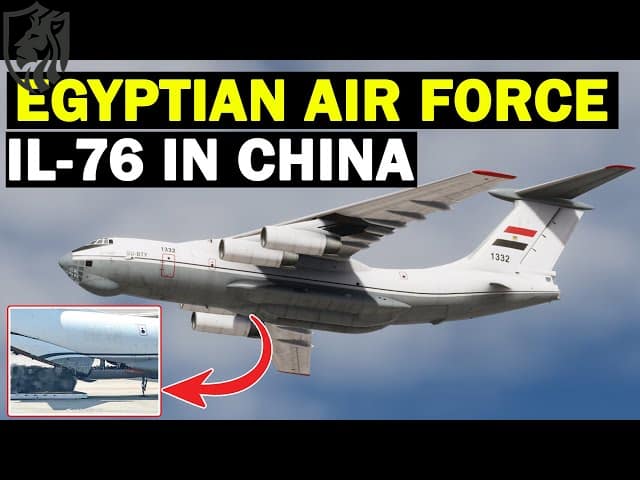
Egyptian IL-76 in China
Many now speculate that China may deliver air defense systems to Egypt using an Egyptian Air Force IL-76MF. This aircraft recently left China and is stopping in Pakistan, sparking even more public interest.
Earlier this week, the flight drew attention as neither Cairo nor Beijing confirmed the cargo’s nature. Observers believe the mission connects to Egypt and China’s growing military cooperation, including “Eagles of Civilization 2025” drills.
Still, without confirmation, the aircraft might be carrying routine supplies, personnel, or unrelated cargo. Even so, the flight’s secretive nature and unusual route have triggered wider speculation.
Many now question whether Egypt is increasingly relying on Chinese military hardware for strategic advantage. Meanwhile, China’s deeper role in Middle Eastern defense is also gaining attention due to this timing.
The Egyptian Air Force relies heavily on the IL-76MF, a Soviet-designed cargo plane with a 60-tonne capacity.
It can travel about 4,000 kilometers when fully loaded, making it perfect for long-range military logistics. The plane is 46.6 meters long and has a wingspan of 50.5 meters.
Aviadvigatel D-30KP turbofan
It has four Aviadvigatel D-30KP turbofan engines. The size makes it possible to carry large items, like parts for air defense systems, such as radars, missile launchers, or command modules.
The aircraft’s large cargo hold, which can accommodate 24.5 tons of items such as air defense parts, contains a significant amount of military equipment. Its capacity makes it a good choice for moving systems, like China’s HQ-9B air defense platform.
For moving systems, such as China’s HQ-9B air defense platform, its capacity makes it an excellent option. Its capacity for long-haul flights makes it even more useful for these kinds of jobs.
The Il-76MF has the same amount of cargo space as Western planes like the Boeing C-17 Globemaster III, but it costs less to run and doesn’t have as many advanced electronics or a global reach.
The flight has sparked considerable speculation following a post on X, in which an observer noted that the Il-76MF departed from China and stopped in Pakistan, leading to the suggestion that it could be transporting air defense systems.
This claim has not been backed up by official sources, and neither the Egyptian nor Chinese governments have made statements explaining the purpose of the flight.
The fact that the transit stop is in Pakistan, which is a close ally of China and gets military equipment from China, makes it even more intriguing.
Chinese HQ-16
Pakistan has collaborated with Beijing on joint defense projects and utilizes Chinese-made systems such as the HQ-16. The stop raises questions about whether it was just for logistics or part of a larger effort to coordinate with other countries in the region.
There has been a lot of speculation because no one has been honest about what happened. Some analysts think the flight may have something to do with the “Eagles of Civilization 2025” exercises that started in April at Egypt’s Wadi Abu Rish Air Base.

Egypt’s military ties with China have grown rapidly recently, fueling these rumors. Egypt says it purchased the HQ-9B air defense system in 2017.
China’s Aerospace Science and Industry Corporation manufactures this long-range surface-to-air missile system. Egyptian defense officials confirmed the purchase at the Egypt Defence Expo (EDEX).
They provided no details about how many systems were bought or their deployment locations. The HQ-9B is often compared to Russia’s S-300PMU-2 system.
It is designed to counter multiple air threats, including fighter jets and cruise missiles. It can also target short-range ballistic missiles effectively.
The system has a range of 200 kilometers and a maximum altitude of 27 kilometers. It uses a phased-array radar to detect and track targets.
This radar can monitor multiple threats at the same time. The missiles use inertial navigation and active radar homing to locate their targets.
HQ-9B’s radar
This makes them effective against modern aircraft and advanced weapons. The HQ-9B’s radar is believed to be based on the HT-233 model.
For long-range stealth aircraft detection, it makes use of AESA technology. The system’s command-and-control structure links it with other air defense assets.
The system creates a multi-layered defensive network. Egypt can buy the HQ-9B for much less than Western systems like the U.S. Patriot PAC-3.
Western systems are pricier and come with political conditions. China’s open export terms make the HQ-9B attractive for nations avoiding alignment with Washington or Moscow.
Compared to Russia’s S-400, the HQ-9B has similar capabilities but costs less. However, it has not been in combat as much as its Russian or American counterparts.
Egypt’s purchase of the HQ-9B was a big step towards getting arms from more than one source. This is a trend that has been picking up speed over the past ten years.
Egypt has historically relied on U.S. military aid, such as the F-16 Fighting Falcon and MIM-23 Hawk air defense batteries. To become less reliant on Washington, Egypt is turning increasingly to partners outside of the West.
Wing Loong II unmanned
China has become an important player in this change. It gives Egypt high-tech equipment like the Wing Loong II unmanned combat aerial vehicle, a multirole drone that can carry out precise attacks and gather intelligence.
The drone has a range of 1,500 kilometers, a synthetic aperture radar, and electro-optical sensors. It can carry up to 480 kilograms of weapons, which makes it a useful tool for Egypt’s counterterrorism operations in the Sinai Peninsula.
Egypt has also looked into Chinese naval platforms. Although there have been discussions about Type 054A frigates, there has been no official confirmation of contracts.
The joint air exercise, “Eagles of Civilization 2025,” which started on April 19, shows that ties between Cairo and Beijing are getting stronger.
Both countries’ advanced planes participate in the drills at Wadi Abu Rish Air Base. These include China’s J-10C multirole jets and Egypt’s MiG-29M/M2 fighters, both manufactured in Russia.
KJ-500 airborne early warning
YU-20 tankers and KJ-500 airborne early warning and control aircraft also support the drills. A statement from Egypt’s Armed Forces says the goal of the exercise is to improve how the two air forces work together and share tactical knowledge.
The Chinese Ministry of National Defence called the drills a big step forward in military cooperation between the two countries and emphasized how they helped build trust between them.
Asia Live published satellite images from April 17 that showed a Chinese Y-20 airlifter at the airbase. The imagery suggests that the exercise had a lot of logistical support.
High-tech equipment, like the KJ-500, whose AESA radar provides real-time situational awareness, shows that the drills are testing complicated scenarios, which might include integrated air defense operations.
The Il-76MF’s flight could have something to do with these exercises; it could have been transporting Chinese personnel, spare parts, or support gear. It could also be a separate logistical operation, like sending maintenance kits for Egypt’s current HQ-9B systems.
The airplane’s ability to carry large radar arrays or missile containers makes it a potential candidate for transporting air defense parts.
However, until official confirmation, other possibilities, like medical supplies, communications equipment, or even humanitarian aid, cannot be ruled out.
The stopover in Pakistan makes things more complicated because it means the flight may have needed to refuel in the middle of its journey or may have been coordinated with Pakistani authorities for reasons that have not been made public yet.
KJ-500 airborne early warning
Pakistan maintains military ties with China, operating the JF-17 Thunder fighter that Beijing co-designed. These ties point towards a larger network of defense cooperation, which could include Egypt.
High-tech equipment, like the KJ-500, whose AESA radar provides real-time situational awareness, shows that the drills are testing complicated scenarios, which might include integrated air defense operations. Nations such as Saudi Arabia, Pakistan, and Serbia have deployed HQ-9B and HQ-22.
China, unlike Western suppliers, doesn’t put as many limits on the sharing of technology. This means that client states can easily add China’s systems to their existing arsenals.
Because of this, China is now a direct competitor to the US and Russia in the global arms market, especially when it comes to air defense systems.
Some countries want advanced capabilities at a much lower cost than systems like the Patriot or S-400. The HQ-9B, for example, fills that need.
Its radar and missile technologies are based on what China has learned from its air defense programs. For instance, the system employs artificial intelligence to prioritize and monitor targets. However, modern threats like hypersonic missiles have not yet tested the system in combat.
Egyptian-Chinese Relations
Egypt’s decision to strengthen ties with China is based on both practical and geopolitical factors. As a U.S. ally that gets $1.3 billion a year in military aid, Cairo has always kept its partnerships in check to stay flexible.
Egypt sought other options because it didn’t like how the U.S. limited arms sales, especially after the political crisis in 2013 that caused aid to be temporarily cut off.
China is a beneficial partner because it is willing to provide advanced systems without any political conditions.
At the same time, Egypt needs a strong air defense network because it is close to war zones like Libya and Sudan, and it is responsible for keeping the Suez Canal safe.
The HQ-9B can defend against threats from nearby states or non-state actors, which fits with Egypt’s need to show strength in a dangerous area.
Egypt’s air defense strategy has gone through several stages over the years. During the Cold War, it relied on Soviet systems like the SA-2 and SA-3, which were used against Israeli planes in the 1967 and 1973 wars with mixed results.
In the 1980s, they switched to U.S. systems like the Improved Hawk and later the Patriot. The result was a return to Western technology.
Cost and strategic independence led to the implementation of Chinese systems in the 2010s, indicating a return to diversity.
U.S. and Russian systems
The placement of the HQ-9B, likely along Egypt’s northern coast or near critical infrastructure such as the Suez Canal, enables it to intercept aerial attacks; however, connecting it to U.S. and Russian systems will be challenging.
The fact that the system depends on Chinese software and maintenance help could also make it vulnerable, especially during a long conflict that disrupts supply chains.
The specifications for the Il-76MF make it clear that it can carry air defense systems. The plane can carry up to 210 tonnes, which is the full weight of an HQ-9B battery, complete with radar, command vehicle, and missile launchers, on a single flight.
Its four engines supply it the thrust it needs to carry heavy loads, and its reinforced landing gear lets it take off and land on rough surfaces, which is crucial in Egypt’s varied terrain.
The plane can go on long-distance missions like the one from China to Egypt via Pakistan because its range can be increased by refueling in the air.
Despite lacking the modern avionics and fuel efficiency of the Y-20, the Il-76MF remains a reliable platform for heavy-lift operations.
Eagles of Civilization 2025
Since neither Egypt nor China has made official statements, the flight’s purpose is still up for debate. The “Eagles of Civilization 2025” drills, as Egypt Today reported, aim to boost long-term military cooperation.
Therefore, the Il-76MF’s presence in China might directly relate to these multi-day joint exercises. These drills include complex maneuvers and advanced aircraft, demanding significant logistical planning and coordination.
As a result, Egypt may have needed to move key equipment or personnel for the exercises. The flight took place soon after the drills began, raising speculation about a parallel mission.
This timing suggests Egypt may be working on strengthening its air defense capabilities separately. Meanwhile, the HQ-9B’s modular design allows for upgrades, including new radar software and missile variants.
Consequently, Egypt may require shipments from China to support those potential enhancements. China’s overall plan for the Middle East is to use sales of weapons to build long-term relationships with other countries.
Reaching out to Gulf states, like Saudi Arabia’s membership in the Shanghai Cooperation Organisation, shows that the country is working hard to gain more power.
Mediterranean and Red Sea
Egypt is a key player in the area and a natural partner for Beijing because it provides them with access to the Mediterranean and a strategic location close to Israel and the Red Sea.
The joint drill and possible arms transfers show a change in the balance of power in the region, which makes it harder for the US to control the Middle East’s defense market.
Egypt’s relationship with China gives it negotiating power with the United States, which helps Cairo get better terms for future arms deals.
The mystery surrounding the Il-76MF flight shows how opaque modern arms transfers are, especially when they involve countries that are not Western.
Even though the flight may have been normal, the timing and route have left people wondering about Egypt’s defense priorities and China’s goals.
HQ-9B is the main part of Egypt’s plan to update its air defenses. It is a practical choice for a country that has to deal with a complicated political situation.
Still, its inclusion in Egypt’s arsenal alongside U.S. and Russian systems shows how difficult it is to maintain a cohesive defense strategy.
As China continues to develop complex maneuvers and high-tech aircraft, they require a lot of planning and organization. It’s not clear whether this flight is the start of a new phase in Cairo’s relationship with Beijing or just a technical detail.
There are a growing number of competing interests in the Middle East, and transparency could be the key to putting a stop to the rumors.
Conclusion
From my view, this event shows how non-Western powers are reshaping global defense relationships.
Egypt’s pivot to China seems logical, yet it may strain its long-standing ties with the United States.
Especially if future arms deals materialize, tensions with Washington could grow sharper and harder to ignore.
While the HQ-9B looks impressive on paper, it still lacks real-world combat experience.
Therefore, many now question its reliability compared to battle-tested systems like the Patriot or S-400.
Meanwhile, the secretive nature of the flight—common in military logistics—further fuels regional mistrust.
If Egypt expands its Chinese arsenal, it might signal a tougher stance on regional security matters.
However, this shift could also reduce its flexibility in adapting to future strategic needs.
Only time—and perhaps a rare official statement—will reveal Egypt’s true intentions.
References
- Egypt’s IL-76 spotted in China sparks speculation
🔗 https://tinyurl.com/egypt-il76-china - HQ-9B air defence system overview – Army Recognition
🔗 https://tinyurl.com/hq9b-overview - Egypt Defence Expo (EDEX) – Official website
🔗 https://tinyurl.com/egypt-edex - China’s growing arms sales to the Middle East – SIPRI
🔗 https://tinyurl.com/china-mideast-arms - Joint China-Egypt military exercises – Asia Live
🔗 https://tinyurl.com/china-egypt-drills - Overview of IL-76MF capabilities – GlobalSecurity.org
🔗 https://tinyurl.com/il76mf-capabilities - HQ-9B vs Patriot PAC-3 comparison – Defense Update
🔗 https://tinyurl.com/hq9b-vs-patriot - Egypt’s military aid from the US – CRS
🔗 https://tinyurl.com/egypt-us-aid - China’s export of air defense systems – Defense News
🔗 https://tinyurl.com/china-air-defense - Chinese AESA radar technology – Janes
🔗 https://tinyurl.com/chinese-aesa-radar










